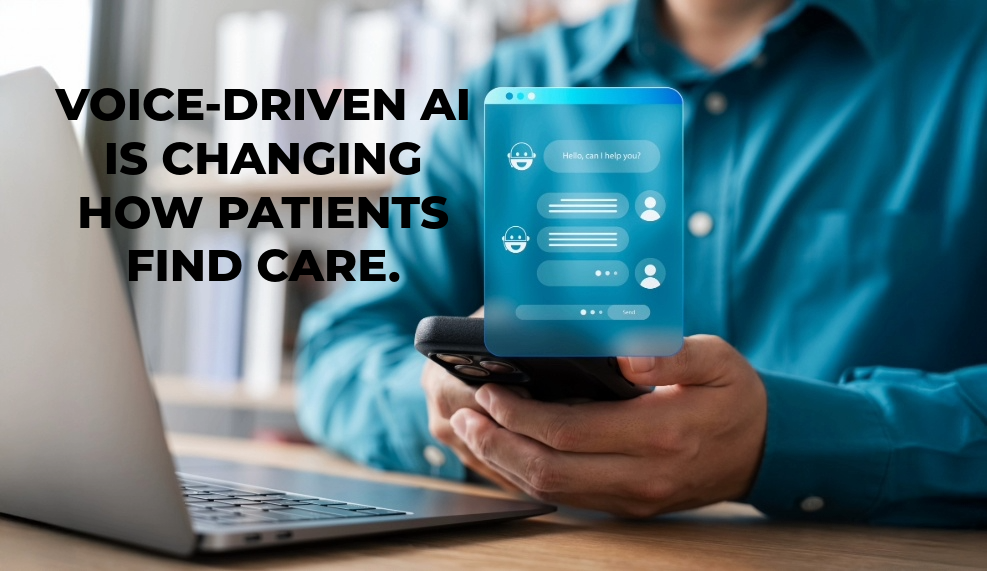Editor’s Note: This blog was written by the team at My Social Practice. It’s Part 1 of 3 of a deep-dive into what AI means for your dental marketing (and what to do about it).
Dental SEO strategy is changing rapidly, and many patients have already shifted to the new generation of consumer data gathering; the tried and true strategies you’ve been using for years are as relevant as flip phones.
Here's what nobody tells you: while you've been dutifully optimizing for "best dental implants" keywords and cramming "dentist near me" into every paragraph, your potential patients have already moved on to asking their phones, "Hey Siri, where can I get my tooth fixed without waiting three weeks?"
The dental marketing game has fundamentally changed, and most practices are still playing by 2015 SEO rules.
The Death of Traditional Dental SEO (And Why That's Actually Good News)
Remember when dental marketing meant stuffing "emergency dentist" into your content seventeen times per page? Those days are dead, killed by AI that's smart enough to understand what people actually mean, not just what they type.
Voice search accuracy has exploded. Which means your patients don't need to speak like robots anymore. Instead of typing "dental implant cost comparison," they're directly asking, "How much should I expect to pay for a dental implant, and what factors affect the price?"
See the difference? One sounds like the keyword-stuffed nightmare your dental marketing firm probably recommended. The other sounds like... well, like a human being having a conversation with their dentist.
This shift isn't just happening. It's already happened. Google processes over 8 billion searches daily, and increasingly, these searches look nothing like the traditional dental SEO keywords of the past. They're conversational, context-rich, and frankly, a lot more like the questions your patients ask you in person.
To press on the issue, in April 2025 alone, there were over 185 million AI-driven chat interactions related to healthcare topics. Patients aren’t browsing your keyword-stuffed blog posts anymore, they’re having intelligent, real-time conversations with AI about dental implants, tooth pain, and whitening options.
The following graph illustrates the explosive growth in ChatGPT usage from January to July 2025, based on data compiled through ChatGPT Deep Search using sources such as The Bridge Chronicle, DemandSage, and Business of Apps.

The reality: Your dental marketing strategy should absolutely not focus primarily on cramming keywords into content.
The AI Bypass: When Patients Skip Google Entirely
Here's where it gets really interesting (and potentially terrifying for your current dental marketing approach): consumers are increasingly bypassing traditional search engines altogether.
Think about it. When someone has a dental question at 11:00 p.m., maybe they're dealing with sudden tooth pain or wondering if that weird spot in their mouth is worth panicking about, where do they go?
Sure, many still hit Google and find your carefully optimized "SEO for dentists" content. But a growing number are using the AI Overviews in Google, which is powered by Google’s LLS called Gemini. But many are opening ChatGPT, Claude, or Perplexity and asking directly: "I have a sharp pain in my upper left molar that gets worse when I drink cold water. What could this be, and how urgent is it?"
These AI platforms don't just spit out a list of dental websites to click through. They provide immediate, conversational answers. They ask follow-up questions. They contextualize information based on the conversation flow.
The uncomfortable truth? If your practice's information isn't being pulled into these AI responses, you're invisible to an increasingly significant portion of your potential patient base. Your traditional dental SEO efforts won't matter if patients never reach search engines in the first place.
How Search Algorithms Are Rewiring Dental Marketing
Let's be honest about what's happening behind the scenes. Google's algorithms have evolved far beyond simple keyword matching. They're now prioritizing something called "semantic search," which is fancy talk for "understanding what people actually mean when they search for dental services."
When someone voice searches "I need a dentist who's good with anxious patients and doesn't judge me for waiting too long between cleanings," the algorithm doesn't just look for pages containing those exact words. It interprets the intent: this person needs a gentle, understanding dentist who specializes in anxious patients and possibly more complex cases due to neglect.
The algorithm then evaluates your dental marketing content based on how well it addresses these underlying needs and concerns, not just whether it mentions "dentist" or "best dentist near me" enough times.
This means your old-school SEO content isn't just ineffective anymore. It's actively working against your dental marketing goals because it sounds robotic and unhelpful.
The bottom line: Your dental marketing firm should always prioritize meaningful communication over delivering content that sounds like it was written by a robot.
The Context Revolution: Why Your Dental Marketing Content Needs to Think Like a Conversation
Here's what's really changed: search engines which are now heavily influenced by AI are evaluating your website content the way your best patient interactions happen through natural, flowing conversation that builds understanding over time.
When a patient walks into your office worried about a potential root canal, you don't immediately start listing your credentials and services. You ask questions. You listen. You address their specific concerns in language they understand. You build context throughout the conversation.
That's exactly how modern search algorithms evaluate your dental practice online content. They're looking for pieces that feel conversational, that anticipate follow-up questions, that build understanding progressively rather than just dumping dental marketing keywords.
Revolutionary concept: your website content should read like the conversations you have with patients, not like a brochure written by an SEO algorithm.
Real-World Impact: What This Means for Your Dental Marketing Strategy
Let's get specific about what this means for dental practices. Consider two pieces of content:
Old-school dental SEO approach: "ABC Dental provides emergency dental services in Downtown City. Our emergency dentist offers same-day emergency dental appointments for dental emergencies including tooth pain, broken teeth, and dental trauma. Contact our emergency dental office for emergency dental care."
New conversational dental marketing approach: "Dealing with sudden tooth pain at 2:00 a.m.? We get it. Dental emergencies never happen at convenient times. Here's what you should know about when to seek immediate care versus what can wait until morning, plus how to manage pain safely until you can get professional help."
The second example addresses the real concerns behind emergency dental searches. It provides immediate value. It sounds like something a caring dentist would actually say to a worried patient.
Plot twist: the second example will rank better in modern search results AND convert more visitors into patients, even though it doesn't mention "emergency dentist" or "dental implants" once in that paragraph.
The Speed of Change: Why "Wait and See" Isn't an Option for Dental Marketing
Anyone telling you this transformation will happen gradually over the next few years is selling you outdated dental marketing advice. The shift is happening now, accelerated by AI integration directly into search results and the growing sophistication of voice assistants.
Google's Search Generative Experience (SGE) already provides AI-generated answers at the top of search results for many dental queries. Microsoft's integration of GPT-4 into Bing. The explosion of ChatGPT usage for dental information gathering. These aren't future possibilities. They're current realities changing how patients find and evaluate dental practices.
The uncomfortable truth: dental practices that adapt to conversational, context-rich content creation will capture an increasingly large share of patient attention. Those that stick with traditional keyword-stuffing dental SEO approaches will find themselves increasingly invisible, regardless of how much they're paying their dental marketing company.
What This Means for Your Dental Marketing Content Strategy
This isn't about throwing out everything you know about dental marketing. It's about evolution, creating content that serves both traditional dental SEO and the new AI-powered landscape.
Your dental marketing content needs to:
- Answer the questions patients actually ask, in the language they actually use
- Provide value immediately, not after clicking through to another page
- Sound like expert advice from a trusted dentist, not marketing copy from a generic template
- Build context progressively, like a good patient consultation
- Incorporate dental SEO naturally within helpful, conversational content
Here's what nobody tells you: this approach doesn't just work better with AI and voice search. It also converts better with traditional website visitors because it actually helps them instead of just trying to rank for keywords.
The practices that embrace this shift, that start creating genuinely helpful, conversational dental marketing content, won't just survive the AI revolution. They'll thrive in ways that traditional dental SEO never could deliver.
Bottom line: the future of successful dental marketing isn't about better keyword density or more sophisticated SEO for dentists techniques. It's about creating content that serves patients so well that both humans and AI algorithms can't help but recommend you.
FAQs
How is voice search changing dental SEO and marketing strategies? Voice searches are conversational and longer, like asking "What should I expect during my first visit to a new dentist?" instead of typing "new dentist first visit." This means your dental marketing content needs to sound natural and address real patient concerns, not just contain SEO keywords.
Should I fire my dental marketing firm if they're still focused on traditional SEO? Not necessarily, but you should demand they adapt their strategies to include conversational content optimization. If they're still primarily focused on keyword density and traditional SEO for dentists techniques, it's time for a serious conversation about updating their approach.
Are patients really using AI chatbots instead of Google to find dental services? Increasingly, yes. Many patients use ChatGPT, Claude, or other AI tools to get immediate answers about dental concerns, especially for urgent questions or when they want detailed explanations without clicking through multiple dental websites.
How do I know if my dental content is AI-optimized? Read it out loud. If it sounds like something you'd naturally say to a patient in your office, you're on the right track. If it sounds robotic or keyword-stuffed, it needs work. Great dental content should be helpful first and optimized second.
And here’s a smart bonus: when your content earns a mention in AI Overviews, those citations can be tracked and reported, so you can see exactly how your helpful content is paying off.
Will traditional dental SEO keywords still matter for my practice? Keywords still matter, but context and natural language matter more. Instead of forcing "best dentist in Nashville" or "dentist near me" keywords into awkward phrases, use them naturally within helpful, conversational content that addresses real patient needs and concerns.
How quickly do I need to adapt my dental marketing for AI search? The shift is happening now, not in some distant future. Dental practices that start creating conversational, helpful content today will have a significant advantage over those that wait to see how things develop. Your dental marketing company should be implementing these changes immediately.








